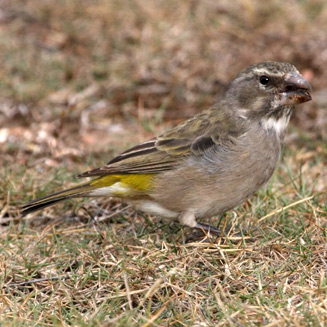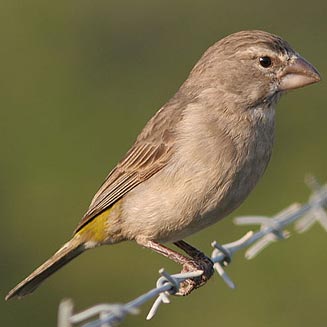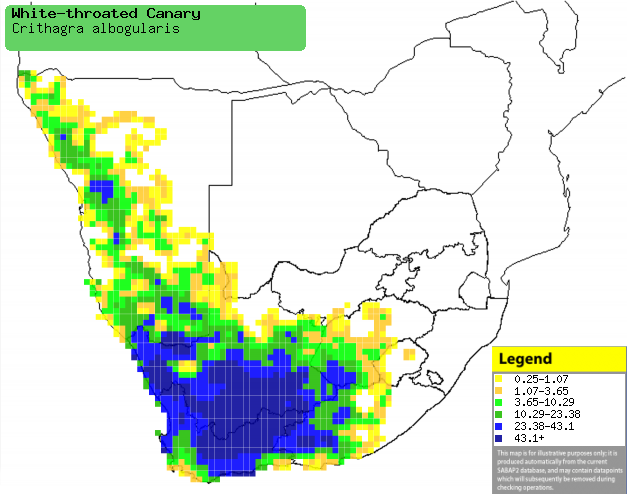|
Crithagra albogularis
(White-throated canary)
[= Serinus albogularis]
Witkeelkanarie [Afrikaans]; Witkeelkanarie [Dutch]; Serin à
gorge blanche [French]; Weißkehlgirlitz [German]; Canário-de-garganta-branca
[Portuguese]
Life
> Eukaryotes >
Opisthokonta
> Metazoa (animals) >
Bilateria >
Deuterostomia > Chordata >
Craniata > Vertebrata (vertebrates) > Gnathostomata (jawed
vertebrates) > Teleostomi (teleost fish) > Osteichthyes (bony fish) > Class:
Sarcopterygii (lobe-finned
fish) > Stegocephalia (terrestrial
vertebrates) > Tetrapoda
(four-legged vertebrates) > Reptiliomorpha > Amniota >
Reptilia (reptiles) >
Romeriida > Diapsida > Archosauromorpha > Archosauria >
Dinosauria
(dinosaurs) > Saurischia > Theropoda (bipedal predatory dinosaurs) >
Coelurosauria > Maniraptora > Aves
(birds) >
Order: Passeriformes > Family: Fringillidae
 |
 |
|
White-throated canary, De Hoop Nature Reserve,
South Africa. [photo
Duncan Robertson ©] |
White-throated canary, Tanqua Karoo, South Africa. [photo Trevor Hardaker ©] |
Distribution and habitat
Near-endemic to southern Africa, occurring from
south-western Angola through Namibia to South Africa, in the Northern, Western
and Eastern Cape as well as in the Free State and Swaziland. It generally
prefers semi-arid and arid shrubland, sparse woodland along drainage lines,
rocky hillside with scattered tall shrubs, coastal strandveld and gardens in
Karoo villages.
|
 |
|
Distribution of White-throated canary in southern Africa,
based on statistical smoothing of the records from first SA Bird Atlas
Project (©
Animal Demography unit, University of
Cape Town; smoothing by Birgit Erni and Francesca Little). Colours range
from dark blue (most common) through to yellow (least common).
See here for the latest distribution
from the SABAP2. |
Predators and parasites
It has been recorded as prey of the
Falco peregrinus
(Peregrine falcon).
Food
It mainly eats seeds supplemented with fruit and insects,
foraging both on the ground and in the foliage of bushes and trees. The following food items have been recorded
in its diet:
- Fruit
- seeds
- Psilocaulon junceum (Asbos)
- Malephora lutea (Vingerkanna)
- Acacia
- Atriplex lindleyi (Blasiebrak)
- Boerhavia repens (Veldpatat)
- Chenopodium (misbredies)
- Emex (Polygonaceae)
- Protea
- Eriocephalus (Karoo rosemaries)
- Erodium (Geraniaceae)
- Lepidium (pepperweed)
- Microloma (Asclepiadaceae)
- Polycarena (Scrophulariaceae)
- Asteraceae
- Euryops
- Relhania
- Kleinia
- Othonna
- Raphanus (wild radishes)
- Salsola (Tumbleweeds)
- Sonchus (sow thistles)
- Stoebe (zig-zag bushes)
- Zaluzianskia (Marsiliaceae)
- Zygophyllum (bean-capers)
- fruit
- Carissa bispinosa (Common num-num)
- Chrysanthemoides monilifera (Bushtick-berry)
- Grewia
- Lycium (honey-thorns)
- Maytenus (silky-barks)
- Olea (olives)
- Atriplex semibaccata (Creeping saltbrush)
- Insects
Breeding
- Monogamous, usually solitary nester, although it may form loose colonies
with a few nest spaced 30-40m apart.
- The nest is built solely by the female, consisting of a loosely built
cup of twigs, dry grass and forb stems, lined with the fluffy seeds of Karoo
rosemaries (Eriocephalus), milkweeds (Asclepias) and pappuses
of daisy flowers, sometimes with wool and feathers as well. It is typically
placed in an upright or horizontal fork of a tall shrub or small tree,
especially the following species:
- shrubs
- Rhigozum obovatum (Granaatbos)
- Salsola aphylla (Gannabos)
- Euphorbia mauritanica (Melkbos)
- small trees
- Acacia karroo (Sweet thorn)
- Rhus lancea (Karee)
- Rhus undulata (Kuni-bush)
- Egg-laying season is mainly from August-October in South Africa,
although in semi-arid areas it is probably year-round, corresponding to
rainfall.
- It lays 2-5 eggs, which are incubated solely by the female for about
14-18 days.
- The chicks are fed by both parents on a diet of regurgitated insects and
seeds, leaving the nest after about 16 days.
Threats
Not threatened.
References
-
Hockey PAR, Dean WRJ and Ryan PG 2005. Roberts
- Birds of southern Africa, VIIth ed. The Trustees of the John Voelcker
Bird Book Fund, Cape Town.
|
